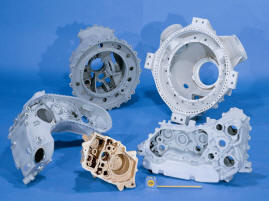Aircraft Component Machining
 A
smaller but well-known aircraft company attempted to implement Lean Manufacturing for their
machine shop and subassembly operations. The Kaizen Blitz was their primary approach. They
employed consultants who came in with the usual panoply of edicts and pronouncements: A
smaller but well-known aircraft company attempted to implement Lean Manufacturing for their
machine shop and subassembly operations. The Kaizen Blitz was their primary approach. They
employed consultants who came in with the usual panoply of edicts and pronouncements:
-
Inventory is evil and must be eliminated regardless of all other considerations.
-
The primary measure of work-cell performance is throughput time.
-
Machine utilization is of no consequence and should be ignored.
-
Work-cells must have a straight-through flow for all products.
-
Work-cells must have one-piece flow.
-
Low-tech, manual machine tools are superior to high-tech NC equipment.
-
Lot sizes must be cut drastically.
 These
edicts apply to many manufacturing situations including this particular manufacturer's
subassembly cells. Indeed, the subassembly cells functioned quite well. These
edicts apply to many manufacturing situations including this particular manufacturer's
subassembly cells. Indeed, the subassembly cells functioned quite well.
Things did not work so well in machining. Here, a very low-volume, high-variety product mix
combined with the above beliefs brought the following results:
|
-
Straight-through flow precluded many parts from a particular cell. These inconvenient
parts were simply outsourced.
- Since Lean efforts were restricted to Kaizen Blitz' at the cells, no effort was
made to provide purchasing the tools they needed to monitor inventories. With many more
parts now being outsourced, inventories of purchased machinings mushroomed.
- Failure
to adequately implement setup reduction brought even less capacity as lot sizes were
reduced.
-
Machining cells were initially tied to particular subassemblies rather than families of
similar piece parts. This resulted in sub-optimum cells and limited the number of parts
available to a workcell. Many cells were starved for work.
-
Operations were taken off of NC equipment and replaced by a series of operations on
manual machines. The multiple fixtures produced tolerance buildups and created severe
quality problems for some items.
-
Eventually, so many parts were outsourced and so little produced that the shop could not
cover fixed cost. This did not seem readily apparent, however, because of the fixation on
throughput time and WIP as the only significant metrics.
 The
overall result was layoffs, higher inventories, an unprofitable cost structure, management
changes, and severe pressure from the corporate masters. The
overall result was layoffs, higher inventories, an unprofitable cost structure, management
changes, and severe pressure from the corporate masters.
Other Examples
Is The Kaizen Blitz Right For
You?
Kaizen Blitz Overdose
Kaizen & One Piece Flow
Rationalized Workcell Design
Workcell Design Seminary
Historical Note:
The guiding beliefs discussed here derive from Toyota's JIT starting in the early 1950's.
Such beliefs were useful for Toyota and similar manufacturers. They do not apply to all
situations.
A low-volume, high-variety machine shop is one situation where these guiding beliefs do not
apply directly.
|






